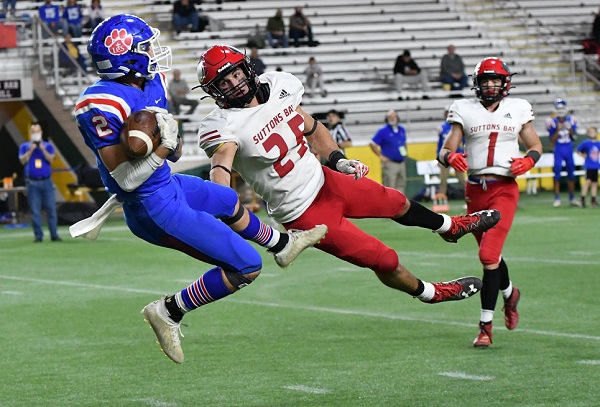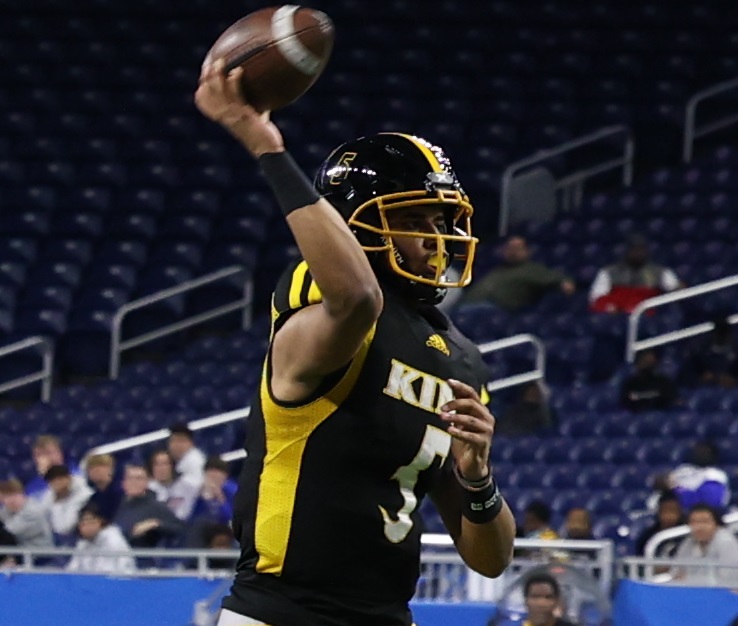
Inside Selection Sunday: Mapnalysis '15
October 26, 2015
By Geoff Kimmerly
Second Half editor
Consider that one hour Sunday night was the product of nine weeks of games on top of two more weeks of practice, hours of lifting weights, conditioning and camps and a total of six months of work at the MHSAA office, in addition to hours upon hours put in by athletic directors scheduling years in advance.
The anticipation for the release of another year's MHSAA Football Playoff pairings is matched by a giant exhale only after the results are broadcast on Fox Sports Detroit, streamed online and posted on locker room doors and Facebook walls all over our state.
 And then the fun begins again.
And then the fun begins again.
But the Selection Sunday Show is the favorite hour of the season for many fans across our state. And that’s why, for the fifth year, we’ll explain our most difficult decisions in this Mapnalysis 2015 breakdown of how we paired 272 teams that will play next month for championships across nine divisions.
For those familiar with our playoff selection process, or who have read this report in the past and don’t want a refresher on how we do what we do, skip the next section and go directly to the “Observations & Answers: 2015.” For the rest, what follows is an explanation of how we selected the playoff pairings during the morning hours Sunday, followed by how we made some of the toughest decisions and a few thoughts on the breakdown of the field.
Ground Rules
Our past: The MHSAA 11-player playoff structure – with 256 teams in eight divisions, and six wins equaling an automatic berth (or five wins for teams playing eight or fewer games) – debuted in 1999. An 8-player tournament was added in 2011, resulting in nine champions total each season.
The first playoffs were conducted in 1975 with four champions. Four more football classes were added in 1990 for a total of eight champions each fall. Through 1998, only 128 teams made the postseason, based on their playoff point averages within regions (four for each class) that were drawn before the beginning of the season. The drawing of Districts and Regionals after the end of the regular season did not begin until the most recent playoff expansion.
In early years of the current process, lines were drawn by hand. Dots representing qualifying schools were pasted on maps, one map for each division, and those maps were then covered by plastic sheets. Districts and Regionals literally were drawn with dry-erase markers.
Our present: After a late Saturday night tracking scores, we file in as the sun rises Sunday morning for a final round of gathering results we may still need (which can include making a few early a.m. calls to athletic directors). Re-checking and triple-checking of enrollments, what schools played in co-ops and opted to play as a higher class start a week in advance, and more numbers are crunched Sunday morning as the fields are set.
This season, there were a record-low 216 automatic qualifiers by win total – with the final 40 at-large then selected, by playoff-point average, one from each class in order (A, B, C, D) until the field was filled. There were only four Class D additional qualifiers with 5-4 or 4-4 (playing eight games) records from which we could choose – so after those four we added 12 teams each from Class A, Class B and Class C.
Those 256 11-player teams are then split into eight equal divisions based on enrollment, and their locations are marked on digital maps that are projected on wall-size screens and then discussed by nearly half of the MHSAA staff plus a representative from the Michigan High School Football Coaches Association. Only the locations themselves are marked (by yellow dots) – not records, playoff point averages or names of the schools or towns. In fact, mentions of those are strictly prohibited. Records and playoff points are not part of the criteria. Matchups, rivalries, previous playoff pairings, etc. also DO NOT come into play.
The same process is followed for organizing the 8-player bracket, with the difference that the 16 teams are selected purely on playoff-point average.
Geography rules: This long has been rule number one for drawing MHSAA brackets in any sport. Travel distance and ease DO come into play. Jumping on a major highway clearly is easier than driving across county-wide back roads, and that’s taken into consideration. Also, remember there’s only one Mackinac Bridge and hence only one way to cross between peninsulas – and boats are not considered a possible form of transportation. When opponents from both peninsulas will be in the same District, distance to the bridge is far more important than as the bird flies.
Tradition doesn’t reign: Every group of 32 dots is a new group – these 32 teams have not been placed in a bracket together before. How maps have been drawn in the past isn’t considered – it’s hard to say a division has been drawn in a certain way traditionally when this set of 32 teams is making up a division for the first time.
Observations & Answers: 2015
Go north with ease: For the most part, most Regional pairings were easier to draw than in past years. For the most part. Divisions 2 and 4 were not easy, specifically when it came to deciding which teams would be paired with an Upper Peninsula qualifier or a team from the Traverse City area. Keep in mind, distance on these maps isn’t based on how the bird flies, but how a bus would drive. In Division 2, that meant putting Muskegon, Muskegon Mona Shores and Grand Rapids Forest Hills Northern – near U.S. 31 and U.S. 131 – with Traverse City Central instead of sending Midland and Midland Dow west, up I-75 and then east-to-west again on more non-highway roads. In Division 4, we considered pairing Alma and Saginaw Swan Valley with Escanaba instead of Big Rapids and Remus Chippewa Hills. That decision came down to Big Rapids being about 14 miles closer to Escanaba than Swan Valley (Whitehall would go with Big Rapids and Chippewa Hills regardless.).
Four counties wide: Yes, on first glance it looks a little odd that Bay City John Glenn and Orchard Lake St. Mary’s would be in the same Division 3 District – but look at the map as a whole. Eight Division 3 teams are located south and mostly east of St. Mary’s, and John Glenn is the only team that could be considered in the northeastern quarter of the Lower Peninsula (Mount Pleasant and Gaylord are right down the middle and naturals to go with Sault Ste. Marie and Petoskey.). With the thumb playoff qualifiers of near-similar size in Division 4, there were no other options than to create this four-county trip between the Eaglets and Bobcats.
Semifinal selection: When all the Regional lines are drawn for a division, we also must figure out which Regionals will meet for Semifinals. This annually provides some challenges. Do we match east vs. west or north vs. south? If something seems iffy in four weeks when those games are played, again, keep in mind the entire map and entire Regionals that are matched up.
Scheduled strong: Because we’re looking only at dots on a map, we don’t see the matchups until everything is drawn – and in that way, we’re like everyone else. It wasn’t lost on us that two 9-0 teams will have road games this week or three 5-4 at-large qualifiers will be at home. For those 9-0 teams, it’s true: there’s nothing more they could’ve done on the field. But here’s why they will travel.
- Clinton, in Division 6, hasn’t lost a regular-season game since 2011, and in fact plays in a strong Tri-County Conference made up of Class C schools and one Class D. Four of eight from the league made the playoffs, and the competition was so strong that Morenci and Petersburg-Summerfield will host games in Division 8. But Clinton’s opponent, Monroe St. Mary Catholic Central, while it did have one loss, fell to one-loss Class B Lansing Catholic – and the Falcons played eight Class B and one Class A school this season. Beating a Class B team is worth 16 points more than beating a Class C and 32 more than beating a Class D (with those points then divided over the number of games a team plays that season) – and all of that made the difference in St. Mary’s final eight-point playoff average edge over Clinton.
- Saugatuck in Division 7 is a similar story. The Indians are one of three undefeated teams in their District, and did play a pair of Class B opponents. But by no fault of their own, especially in league play where the schedule is set, Saugatuck didn’t face a team this season that won more than five games. Hesperia played three Class B opponents including one that finished 6-3 – enough for the slim 1.8 points more in playoff average that earned the Panthers homefield advantage. Pewamo-Westphalia has the highest average in the District and didn’t play a Class B – the Pirates actually played three Class D teams. But they also beat four teams that made the playoffs including two that finished 8-1 – giving them a 2.7-point edge on Hesperia and 4.5 edge on Saugatuck.
- The 5-4 teams that will host – Redford Thurston in Division 3 and Escanaba and Benton Harbor in Division 4, all earned their spots. Escanaba faced six playoff teams and beat three, Class B Benton Harbor played eight Class A teams, and Thurston played five playoff teams and a sixth that just missed an at-large bid.
At the end of the day ...
What you see is what our committee decided upon after multiple discussions among multiple groups that broke down every sensible possibility we could muster. There are certainly points open to argument – and we likely made those arguments as well.
Those who would like to see the playoff selection process changed are in favor of a larger strength-of-schedule component, and it’s interesting to see how strength of schedule inadvertently made a larger impact this season than in the recent past – especially given the examples above of undefeated teams going on the road and at-large teams hosting.
Why were there fewer automatic qualifiers than ever before? Here's one theory. There were 11 fewer teams in 11-player football this season than in 2014 (most moved to 8-player). An argument can be made that there were fewer wins to be gained against teams that last season might have struggled to field 11-player teams, shifting the balance to fewer automatic qualifiers and more parity with stronger teams facing each other to fill their schedules.
Meanwhile, the 8-player field grew by nine teams this fall and has its strongest ever, with seven teams that finished 5-4 missing the postseason after a team with a sub-.500 record got in just a year ago.
Given how some matchups shook out this fall, the next argument by those seeking change likely will center on seeding entire Regionals instead of just Districts. But keep this in mind as well: if Regionals were seeded with this year's groupings, it would create possibilities of first-week trips like Battle Creek to Traverse City and Cedar Springs to Sault Ste. Marie. We're fairly sure most coaches and players would dread such journeys for a first-round game.
It's a lot to digest, and the scrutinizing will surely continue long after these playoffs are done as we all work to conduct the best tournament possible.
But at the end of the day – and the end of these next five weeks – to be the best, teams will need to beat the best no matter the matchups. And we’ve got plenty to look forward to starting this weekend and all the way through the 11-player Division 3 Final on Nov. 28 at Ford Field.
The MHSAA Football Playoffs are sponsored by the Michigan National Guard.
PHOTO: The Division 4 map was among the most difficult to draw during this year's selection process.

1st & Goal: 2021 Finals Review
By
Geoff Kimmerly
MHSAA.com senior editor
November 30, 2021
Two of the longest MHSAA Finals days at Ford Field – capped by two of the most exciting championship games in recent memory – concluded the 2021 football season this weekend.
 Fans were able to savor every moment until nearly midnight both nights, and more than 38,000 made the trip to Detroit over the two-day 11-player event. That was in addition to those who journeyed from near and far the weekend before for the 8-Player Finals at Northern Michigan University’s Superior Dome, where a pair of repeat champions reigned again.
Fans were able to savor every moment until nearly midnight both nights, and more than 38,000 made the trip to Detroit over the two-day 11-player event. That was in addition to those who journeyed from near and far the weekend before for the 8-Player Finals at Northern Michigan University’s Superior Dome, where a pair of repeat champions reigned again.
Second Half covered all 10 championship games, with quick recaps and links (click on the game scores) to those stories below followed by notations of performances entered into the MHSAA Finals record book and a report on some of the biggest and best stories to emerge from the championship weekends.

Finals in Review
11-Player Division 1: Belleville 55, Rochester Adams 33
After falling a win short of reaching the Final the last three seasons, Belleville advanced this fall and completed its first championship run. Freshman quarterback Bryce Underwood showed on a statewide stage why he’s received lots of attention during his high school debut, and he was surrounded by seniors including receiver Jeremiah Caldwell who helped carry the Tigers to the win.
11-Player Division 2: Warren De La Salle Collegiate 41, Traverse City Central 14
After falling in last season’s championship game, De La Salle took the next step in winning its fourth Finals title – and with expectations we could see the Pilots back at Ford Field again in 2022. Junior quarterback Brady Drogosh has been a big part of both trips, and this time he had a hand in 316 total yards and four touchdowns either running or passing.
11-Player Division 3: Detroit Martin Luther King 25, DeWitt 21
Two of the state’s premier quarterbacks were on display, junior Dante Moore for King and senior Ty Holtz for reigning champ DeWitt. But the deciding play was a defensive stand – specifically, the Crusaders stopping a 4th-and-goal from their 1-yard line with 2:34 to play. Both teams brought interceptions back for touchdowns, Holtz making the grab and score for DeWitt.
11-Player Division 4: Chelsea 55, Hudsonville Unity Christian 52
This is the game from this weekend many will be referring to years from now. Take your pick why – the 11-Player Finals record 107 combined points, Chelsea’s also-record 28-point comeback over the final 23 minutes, the fact Unity Christian had set the season record for points scored during the game. Maybe the walk-off field goal by Hunter Shaw saved in part by the deft handling of a short snap by quarterback/holder Lucas Dunn.
11-Player Division 5: Grand Rapids Catholic Central 31, Marine City 7
The Cougars won their second-straight championship in Division 5 and fifth over the last six seasons to go with Division 4 titles in 2016, 2017 and 2019. They did so with what has to be one of the finest back-up quarterbacking performances ever – senior John Passinault stepped in for injured past Finals star Joey Silveri and threw for 2,307 yards and 37 touchdowns this fall.
11-Player Division 6: Lansing Catholic 16, Warren Michigan Collegiate 6
The Cougars have been known for their offensive production over the last decade or more, but the defense led the way to their second championship in three seasons – they had won Division 5 in 2019. Lansing Catholic gave up only 40 points – or eight per game – during this playoff run, and in this game took advantage of four interceptions and a fumble recovery.
11-Player Division 7: Pewamo-Westphalia 14, Lawton 10
The Pirates added their fourth championship in six seasons, capping a run which saw them win their league and defeat eight more league champions along the way – one of them Lansing Catholic, the eventual Division 6 title winner. P-W had accomplished most of it with key players out with injuries, but multiple returned to lead the Pirates past Lawton, which was making its first Finals appearance.
11-Player Division 8: Hudson 14, Beal City 7
Defense has reigned in Division 8 the last few seasons, with Hudson following recent champions Centreville and Reading in thriving on that side of the ball. The Tigers ended their undefeated season having given up only 99 points (7.1 per game), and this time stopped a Beal City team averaging 35.5 points per contest entering Ford Field.
8-Player Division 1: Adrian Lenawee Christian 31, Suttons Bay 20
A rematch of last season’s Division 1 Final was more closely contested, but with the same result as Lenawee Christian finished its second-straight undefeated campaign. Cougars quarterback Ashur Bryja is a name to remember – he opened the scoring 51 seconds in with an interception return touchdown, ran for two more scores and threw for 229 yards.
8-Player Division 2: Powers North Central 63, Colon 0
The Jets won their second-straight Division 2 title and fourth 8-player championship total, and put up a combined 133 points over those last two Finals wins. North Central had 520 yards of total offense this time. Wyatt Raab, Luke Gorzinski and Alex Naser all scored two touchdowns, and Gorzinski also was the team’s leading tackler.

Records Report
11-Player
Chelsea and Hudsonville blew past the previous record of 94 combined points in an 11-Player Finals game with their combined 107. Chelsea’s 55 tied for third-most, with Unity Christian now sitting at sixth on that list after Belleville also scored 55 in Division 1.
As expected from a 55-52 game, Chelsea ended up with the fourth-most total yardage in 11-Player Finals history, with 533, and the teams’ combined total of 1,024 ranks second. Chelsea’s 28 first downs are tied for third-most.
Chelsea’s Lucas Hanifan tied 11-player championship game records with 30 points and five touchdowns, and set the receiving touchdowns record by two with that total. His quarterback Lucas Dunn set the 11-Player Finals record with six touchdown passes while also making the yardage list with 308, pass attempts list with 36 and completions list with 25. Hanifan’s nine receptions also rank among the most in that category.
Belleville freshman quarterback Bryce Underwood may have even exceeded high expectations with his Finals debut, making the total offense list with a combined 346 rushing and passing yards (with 284 passing) and tying for second with four others with five touchdown passes. Senior receiver Jeremiah Caldwell played a big part, tying for second with 204 receiving yards (on only four receptions) and also tying for second with three touchdown catches.
Warren De La Salle Collegiate became the 22nd team to keep an opponent from completing a pass, shutting out Traverse City Central on its nine attempts. Detroit Martin Luther King became the 29th team to not punt in an 11-Player Final.
De La Salle quarterback Brady Drogosh also made the total yardage list with 316 (including 174 rushing). King’s Dante Moore made the completions list with 18 on 24 attempts.
Chelsea’s Hunter Shaw and Belleville’s Brayden Lane tied the 11-Player Finals record held by three others with seven extra points, while in Division 2, De La Salle’s Brady Lowe made the extra point list with five. Shaw and Adams’ Colin Timko became the 11th and 12th, respectively, to make two or more field goals, Timko hitting from 27 and 35 yards in the Division 1 game and Shaw from 26 and 33.
Hudson’s march to victory included 282 rushing yards on 64 carries, which tied for the eighth-most runs by one team in an 11-Player Final.
8-Player
Powers North Central’s big win was accompanied by multiple scoring record book entries, including for 29 points in a quarter (third most), 49 in the first half (first) and 63 for one game (also ranking third). The Jets also made the team rushing yardage list with 328 and the team first downs list with 20. North Central also became the first in the category for fewest rushing yards allowed, holding Colon to -14.
Adrian Lenawee Christian set the team first downs record with 24 against Suttons Bay.
Lenawee Christian quarterback Ashur Bryja earned the sixth-most total yards in 8-Player Finals history, with 372 including 229 passing.
North Central’s Jaden Walters set the standard for 8-player championship game kickers, making all seven of his extra point attempts.
Suttons Bay’s August Schaub set a record that will be tough to match, returning an interception 99 yards for a touchdown against Lenawee Christian.
Teammate Hugh Periard was added with the second-longest rushing play in 8-Player Finals history, 90 yards against Lenawee Christian.

Stories Behind the Scores
Winning streaks grow: A few of this season’s winners not only repeated as champions, but extended overall winning streaks that will be followed closely next season. Grand Rapids Catholic Central has won 36 straight games, tied for the sixth-longest undefeated run. Lenawee Christian has won all 24 8-player games it’s played over the last two seasons, and North Central also is 24-0 over the last two.
What’s new is new: Belleville and Chelsea were first-time champions after some just-misses over the last decade. As noted above, the Tigers made the Semifinals this season for the fourth straight year before reaching Ford Field for the first time, and Chelsea has made the Semifinals five of the last seven seasons and had lost in Finals in 2015 and 2018.
QB Power: Michigan is graduating another fine class of high school quarterbacks – DeWitt’s Ty Holtz, in particular, provided two seasons of memories leading the Panthers on back-to-back trips to Ford Field. But we should expect to see some of the other 2021 championship signal-callers a lot next season. King’s Dante Moore will close one of the most highly-followed careers in some time, and De La Salle’s Brady Drogosh will be watched just as much next fall. Belleville’s Bryce Underwood will generate plenty of statewide interest over the next three seasons. As noted, Lenawee Christian’s Ashur Bryja is one of the next stars among the small schools, and North Central’s Luke Gorzinski has led two championship runs and still is just a junior. Two more to remember: Marine City junior Jeffery Heaslip was a standout run/pass threat in leading his team to the Division 5 Final, and Rochester Adams junior Parker Picot became known at least in-state as much for football leading his team in Division 1 as he’s known as a top-level baseball prospect.
No taking ‘normal’ for granted: Those who experienced the start-stop-start 2020 season will never forget it, nor should any of us who had the opportunity to enjoy a more “normal” 2021. With COVID-19 ever present, Michigan high schools did their parts again to play safely this fall. And proper perspective remains a great teacher of just how much that’s worth.
Second Half’s weekly “1st & Goal” previews and reviews are powered by MI Student Aid, a part of the Office of Postsecondary Financial Planning located within the Michigan Department of Treasury. MI Student Aid encourages students to pursue postsecondary education by providing access to student financial resources and information. MI Student Aid administers the state’s 529 college savings programs (MET/MESP), as well as scholarship and grant programs that help make college Accessible, Affordable and Attainable for you. Connect with MI Student Aid at www.michigan.gov/mistudentaid and find more information on Facebook and Twitter @mistudentaid.

